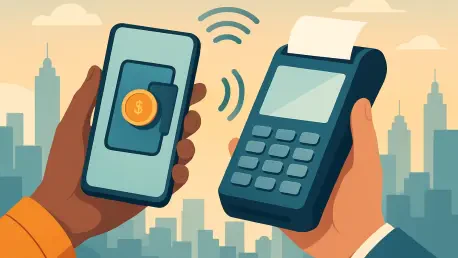Imagine a world where physical wallets are relics of the past, where a simple tap on a smartphone can settle a bill, transfer funds across continents, or even pay for a street vendor’s goods in seconds, transforming the way we interact with money every day. This isn’t a distant dream but the reality unfolding today, driven by the meteoric rise of mobile payments. Across the globe, from bustling urban centers to remote villages, digital transactions are overtaking cash as the preferred method of exchange. This transformation is fueled by rapid technological advancements and a shift in consumer behavior toward convenience and security. The implications are profound, not just for individuals but for economies and businesses adapting to a cashless society. As mobile payments continue to gain traction, they’re paving the way for a financial landscape where digital money reigns supreme, challenging traditional banking systems and opening new avenues for innovation. This shift raises critical questions about how technology, global markets, and user needs are converging to redefine the very concept of money.
The Engine of Innovation Driving Digital Transactions
Mobile payments owe their rapid ascent to a suite of groundbreaking technologies that prioritize speed, safety, and ease of use. At the heart of this revolution lies artificial intelligence (AI), which major players deploy to detect fraudulent activities in real time and offer personalized financial insights to users. This technology ensures that transactions remain secure while adapting to individual preferences, building trust among consumers. Beyond AI, the integration of 5G connectivity has drastically reduced transaction times, enabling near-instantaneous payments even in high-traffic scenarios. Blockchain technology also plays a pivotal role, providing a decentralized framework that enhances security and transparency for cross-border transfers. These innovations collectively form the backbone of a system that’s not just replacing cash but reimagining how value is exchanged in a digital age, setting a new standard for financial interactions worldwide.
The impact of these technological advancements extends beyond mere convenience, reshaping entire industries. For instance, real-time payment processing, powered by high-speed networks, allows businesses to manage cash flow more efficiently, while tokenized transactions minimize risks of data breaches. Meanwhile, AI-driven tools are evolving to anticipate user needs, offering tailored recommendations that make financial management seamless. This convergence of tech isn’t limited to consumer-facing applications; it also underpins the infrastructure that financial institutions rely on to handle trillions in transactions annually. As these tools become more sophisticated, they’re dismantling barriers that once slowed down traditional payment systems, enabling a smoother transition to a cashless economy. The relentless pace of innovation suggests that what’s cutting-edge today may soon be standard, pushing companies to continuously adapt to stay competitive in this dynamic landscape.
Expanding Horizons in a Borderless Financial World
The reach of mobile payments knows no boundaries, as companies aggressively target untapped markets to bring digital finance to billions of new users. Emerging economies, in particular, are witnessing a surge in adoption, where access to traditional banking is often limited, but smartphone penetration is high. Industry leaders are capitalizing on this by establishing footholds in regions with vast growth potential, tailoring solutions to local needs. The sheer scale of this expansion is evident in the massive transaction volumes processed daily, reflecting how mobile payments are bridging economic divides and fostering financial inclusion. This global push isn’t just about numbers; it’s about creating ecosystems where anyone, anywhere, can participate in the digital economy with just a mobile device.
This worldwide momentum also highlights the strategic importance of scalability in the mobile payments sector. Companies are not merely entering new markets but are building partnerships with local entities to navigate regulatory landscapes and cultural nuances. Such collaborations ensure that services are accessible and relevant, whether it’s facilitating small daily purchases or large international transfers. The ripple effect is significant, as digital payments empower small businesses and individuals in remote areas to connect with broader markets, driving economic growth. Moreover, the focus on cross-border capabilities addresses the needs of diaspora communities, making remittances faster and cheaper than ever before. This global tapestry of mobile payments illustrates a shift toward a more interconnected financial system, where geographic barriers are increasingly irrelevant, and digital access becomes a universal equalizer.
Catering to a Spectrum of Financial Demands
The mobile payments landscape thrives on its ability to serve a wide array of users, from everyday consumers to sprawling corporate entities. Major platforms offer intuitive apps that simplify personal transactions, allowing users to pay for goods, split bills, or save with minimal effort. These consumer-focused solutions prioritize user experience, often integrating features that go beyond payments to include budgeting tools or rewards programs. On the other end of the spectrum, robust infrastructure providers support financial institutions and retailers by processing enormous transaction volumes with precision and speed. This dual approach ensures that whether someone is buying a latte or a bank is settling international deals, mobile payments deliver tailored efficiency that meets specific demands.
Diversity in service offerings also extends to niche areas that address unique challenges within the financial ecosystem. For example, specialized services for remittances tackle the complexities of cross-border money transfers, providing affordable and swift options for immigrant communities. This segmentation allows companies to mitigate risks by not relying on a single revenue stream, while also deepening their impact across different sectors. Additionally, the evolution of these services reflects a broader trend of customization, where solutions are fine-tuned to address pain points like high fees or slow processing times. By catering to varied needs—be it personal convenience, institutional reliability, or targeted support—mobile payments are weaving a comprehensive network that leaves little room for cash to remain relevant. This adaptability underscores the sector’s strength in meeting the demands of a rapidly changing world.
Unlocking Financial Potential for Investors
The mobile payments industry stands as a powerhouse of economic opportunity, with a market valuation already in the trillions and showing no signs of slowing down. Companies at the forefront report remarkable revenue increases and transaction growth, signaling robust health and scalability that attract significant investor interest. These financial metrics aren’t just numbers; they represent a seismic shift toward digital finance as a cornerstone of modern economies. For those looking to invest, the sector offers a compelling mix of established giants with proven track records and agile innovators pushing boundaries, creating a balanced portfolio of risk and reward. The promise of substantial returns is clear as mobile payments continue to capture market share from traditional payment methods.
Beyond immediate financial gains, the long-term outlook for mobile payments suggests sustained growth driven by increasing digital adoption worldwide. Investors are drawn to the sector’s ability to innovate continuously, whether through new tech integrations or expansion into underbanked regions. This adaptability translates into resilience, as companies can pivot to meet emerging demands or regulatory changes. Furthermore, the diversity of business models within the industry—from consumer apps to enterprise solutions—provides multiple entry points for investment, catering to different risk appetites. As digital transactions become the default, the financial allure of this space lies in its role as a catalyst for broader economic transformation, positioning it as a strategic focus for anyone eyeing the future of finance.
Pioneering Trends Redefining Money Movement
As mobile payments evolve, emerging trends like tokenization and stablecoins are poised to revolutionize how value is transferred in the digital realm. Tokenization replaces sensitive data with unique identifiers, enhancing security during transactions, while stablecoins offer a stable digital currency option that operates around the clock, bypassing traditional banking constraints. These developments are gaining traction among industry leaders who see them as solutions to longstanding issues like transaction delays and volatility. The adoption of such technologies signals a move toward a more flexible and secure financial system, where users can transact with confidence, regardless of time or location, pushing the boundaries of what digital payments can achieve.
Equally transformative is the emphasis on personalization within mobile payment platforms, turning them into comprehensive financial hubs. Advanced tools now predict user behavior, offering customized suggestions for spending, saving, or even investing, all within a single interface. This shift reflects a deeper understanding of consumer needs, where convenience is paired with actionable insights to enhance financial decision-making. Such features are not mere add-ons but core components that redefine user engagement, making payments an integral part of broader financial wellness. As these trends mature, they’re likely to accelerate the decline of cash, replacing it with digital alternatives that are not only practical but also deeply integrated into daily life, heralding a new era of financial interaction.
Envisioning a World Beyond Cash
The collective efforts of mobile payment companies paint a vivid picture of a future where digital transactions dominate every facet of financial life. Despite varying strategies—some focusing on user-friendly apps, others on enterprise-grade infrastructure or specialized services—the shared vision remains consistent: a seamless, cashless world powered by technology. This convergence of goals is evident in how AI, blockchain, and high-speed networks are universally adopted to solve distinct yet interconnected challenges. The result is a financial ecosystem where money moves effortlessly, unhindered by physical or geographical limitations, marking a definitive departure from the era of cash.
Reflecting on this journey, it’s clear that the strides made by mobile payment innovators have already begun to reshape global finance in profound ways. Looking ahead, the focus should shift to ensuring accessibility for all, especially in regions still transitioning to digital systems, by investing in education and infrastructure. Governments and businesses must collaborate to address regulatory hurdles and cybersecurity threats that could slow progress. Encouraging the adoption of emerging tools like stablecoins could further stabilize and democratize digital finance. Ultimately, the path forward lies in sustaining this momentum through innovation and inclusion, ensuring that the benefits of a cashless society reach every corner of the globe, solidifying the legacy of mobile payments as a transformative force.









